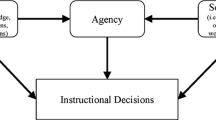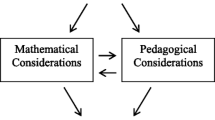Abstract
This paper presents a study of instructors’ and students’ perceptions of the knowledge to be learned about limits of functions in a college level Calculus course, taught in a North American college institution. I modeled these perceptions using a theoretical framework that combines elements of the Anthropological Theory of the Didactic, developed in mathematics education, with a framework for the study of institutions developed in political science. While a model of the instructors’ perceptions could be formulated mostly in mathematical terms, a model of the students’ perceptions included an eclectic mixture of mathematical, social, cognitive, and didactic norms. I describe the models and illustrate them with examples from the empirical data on which they have been built.
Similar content being viewed by others
Notes
The first step in τ1 appears in the textbooks when strategies of calculating limits are described in general. However, this step is omitted in most worked out examples in the textbooks and in solutions written by teachers and made available to students. The same is true for Mathematical Praxeology MP2.
References
Artigue, M., Batanero, C., & Kent, P. (2007). Mathematics teaching and learning at post-secondary level. In F. K. Lester Jr. (Ed.), Second handbook of research on mathematics teaching and learning (pp. 1011–1050). Reston, VA: NCTM.
Balacheff, N. (1999). Contract and custom: two registers of didactical interactions. The Mathematics Educator, 9(2), 23–29.
Barbé, J., Bosch, M., Espinoza, L., & Gascón, J. (2005). Didactic restrictions on the teacher’s practice: The case of limits of functions in Spanish high schools. Educational Studies in Mathematics, 59, 235–268.
Bosch, M., Chevallard, Y., & Gascón, J. (2005). ‘Science or Magic?’ The use of models and theories in didactics of mathematics. 4th Congress of the European Society for Research in Mathematics Education. Sant Feliu de Guixols, Spain, February 17–21, 2005. (http://cerme4.crm.es/Papers%20definitius/11/Bosch%20Chevall.pdf).
Chevallard, Y. (1985). La transposition didactique. Du savoir savant au savoir enseigné. Grenoble: La Pensée Sauvage.
Chevallard, Y. (1992). Fundamental concepts in didactics: Perspectives provided by an anthropological approach. In R. Douady & A. Mercier (Eds.), Research in didactique of mathematics. Selected papers (pp. 131–167). Grenoble: La Pensée Sauvage.
Chevallard, Y. (1999). L’analyse des pratiques enseignantes en théorie anthropologique du didactique. Recherches en Didactique des Mathématiques, 19(2), 221–266.
Chevallard, Y. (2002). Organiser l’étude. 1. Structures et fonctions. In J.-L. Dorier, M. Artaud, M. Artigue, R. Berthelot & R. Floris (Eds.), Actes de la 11e Ecole d’Eté de Didactique des Mathématiques (pp. 3–22). Grenoble: La Pensée Sauvage.
Cottrill, J., Dubinsky, E., Nichols, D., Schwingendorf, K., Thomas, K., & Vidakovic, D. (1996). Understanding the limit concept: beginning with a coordinated process scheme. Jourmal of Mathematical Behavior, 15(2), 167–192.
Goldin, G. A. (1997). Observing mathematical problem solving through task-based interviews. Journal for Research in Mathematics Education. Monograph 9, 289–320.
Kidron, I. (2008). Abstraction and consolidation of the limit procept by means of instructional schemes: The complementary role of three different frameworks. Educational Studies in Mathematics, 69(3), 197–216.
Lithner, J. (2004). Mathematical reasoning in calculus textbook exercises. Journal of Mathematical Behavior, 23, 405–427.
Ostrom, E. (2005). Understanding institutional diversity. Princeton, NJ: Princeton University Press.
Raman, M. (2004). Epistemological messages conveyed by three college mathematics textbooks. Journal of Mathematical Behavior, 23, 389–404.
Sierpinska, A., Bobos, G., & Knipping, Ch. (2008). Source of students’ frustration in pre-university level, prerequisite mathematics courses. Instructional Science, 36, 289–320.
Tall, D., & Vinner, S. (1981). Concept image and concept definition in mathematics, with particular reference to limits and continuity. Educational Studies in Mathematics, 12(2), 151–169.
Voigt, J. (1995). Thematic patterns of interaction and sociomathematical norms. In P. Cobb & H. Bauersfeld (Eds.), The emergence of mathematical meaning. Interaction in classroom cultures (pp. 163–202). Hillsdale, NJ: Erlbaum.
Author information
Authors and Affiliations
Corresponding author
Rights and permissions
About this article
Cite this article
Hardy, N. Students’ perceptions of institutional practices: the case of limits of functions in college level Calculus courses. Educ Stud Math 72, 341–358 (2009). https://doi.org/10.1007/s10649-009-9199-8
Received:
Accepted:
Published:
Issue Date:
DOI: https://doi.org/10.1007/s10649-009-9199-8




